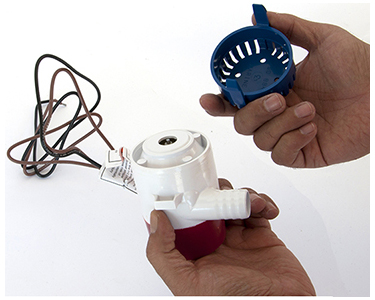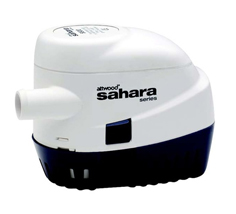
Table of Contents:
- What Does a Bilge Pump Do?
- Types of Bilge Pumps
- Features to Consider
- FAQs
When you're out on the water, the last thing you want to worry about is your boat taking on water where it shouldn't. But between leaky seals, splashing waves, rainwater, and accidental spills, water often finds its way into the lowest part of your boat—the bilge. That's where bilge pumps come in. If you want to know "what is a bilge pump?", you're asking a crucial question for boat safety.
A bilge pump helps keep your boat afloat and dry by removing unwanted water from the bilge area. Even if your vessel isn't legally required to have one, it's a smart investment for peace of mind and safety on the water.
Let's sail through this topic together. We'll explain what a bilge pump does, the different types available, buying considerations, and maintenance tips to keep your bilge system ready for when you need it most.
What Does a Bilge Pump Do?
The next logical question is, "What does a bilge pump do?" It removes water that collects inside the bilge of your boat. The bilge is the lowest compartment inside the hull, and it's a natural collection point for water due to:
- Rain or seawater splashing on board
- Leaks from fittings, hoses, or seals
- Condensation from machinery or fuel systems
- Accidental spills or overflows from tanks
While a small amount of water might seem harmless, left unchecked, it can accumulate quickly—leading to stability issues, equipment damage, or even risk of sinking. The bilge pump's job is to evacuate this unwanted water, helping maintain buoyancy, reduce corrosion, and prevent costly damage.
Types of Bilge Pumps: Choosing the Right One for Your Boat
Understanding your options will help you choose the right system for your boat's size and boating needs.
Automatic Bilge Pumps
These bilge pumps have a built-in float switch that activates the pump when water reaches a certain level. They're convenient for boats that may be left unattended or docked for extended periods. Automatic bilge pumps are required on boats over 20 feet with sleeping accommodations, but are beneficial for any vessel.
Manual Bilge Pumps
These hand-operated pumps are used as a backup or on smaller boats like fishing boats, dinghies, or sailboats. They're simple to install and maintain. Some non-auto pumps can be upgraded with a float switch to mimic automatic functionality.
Diaphragm Pumps
This type of bilge pump can handle higher capacity and prevents clogging from debris. Diaphragm pumps are Ideal for boats where bilge water may contain sand, leaves, or contaminants. You can operate them even when mounted above the waterline.
High-Capacity Engine-Driven Pumps
These bilge pumps are best suited for larger vessels or commercial boats that require fast water evacuation. They're typically powered by the boat's engine or electrical system and can move large volumes of water quickly.
Pro Tip: Have a backup plan! Always keep a five-gallon bucket or hand pump on board as a secondary line of defense. Even the best bilge system can fail if clogged, damaged, or if the power supply is interrupted.
Features To Consider When Buying a Bilge Pump
When shopping for the right bilge pump, keep these important factors in mind:
- Gallons Per Hour (GPH) Capacity: Choose a pump with the appropriate GPH rating for your boat size. More GPH means faster water removal, but make sure your boat's electrical system can support the load.
- Power Source and Voltage: Check whether your boat uses 12V, 24V, or 32V systems. Confirm compatibility with your electrical setup.
- Size and Installation Requirements: Consider available space in your bilge area. Submersible pumps are typically compact, but diaphragm pumps may need more room.
- Ease of Maintenance: Look for pumps with removable cartridges or strainers for simple cleaning. Cartridge bilge pumps offer easy motor replacement without removing the entire unit.

How To Maintain Your Bilge Pump System
Your bilge pump is only as good as its condition. Regular inspection and maintenance ensure it will work when you need it most.
- Routine Testing: Test your bilge pump before each boating season and periodically during use. Fill the bilge with clean water and confirm the pump activates and drains properly.
- Check for Blockages: Inspect the strainer, intake, and discharge hoses for clogs from leaves, sand, or debris. Clean the pump housing regularly to prevent buildup.
- Monitor Electrical Connections: Make sure the wiring is intact, corrosion-free, and secure. Replace worn or corroded connectors as needed.
- Know When to Replace or Upgrade: If your current pump struggles to keep up or frequently jams, it may be time to upgrade to a higher GPH model. Many manufacturers offer drop-in motor replacements if the housing is still in good shape.
Shop Bilge Pumps and Accessories at Wholesale Marine
When protecting your boat from unwanted water, choosing the right bilge pump makes all the difference. At Wholesale Marine, we carry a wide selection of:
Need help finding the best bilge pump for your boat? Our team of boating experts is ready to assist. Contact us at 1-877-388-2628, Monday through Friday, 9 AM to 6 PM ET.
FAQs: What Is a Bilge Pump?
Looking for quick answers about bilge pumps? Here are some of the most common questions boaters ask when choosing and maintaining a bilge pump system.
Do I really need a bilge pump for my boat?
Yes! While not every recreational boat is legally required to have a bilge pump, it's highly recommended. Even small amounts of bilge water can cause big problems if not removed promptly.
How many bilge pumps should I have on my boat?
At least one bilge pump is the minimum, but many boating experts recommend three or four pumps on larger boats for extra safety. It's always a good idea to have both automatic and manual options along with a bucket as backup.
What is the difference between automatic and manual bilge pumps?
Automatic bilge pumps feature a float switch that triggers the pump when water levels rise, offering hands-free operation. Manual pumps require hand activation but are great as a secondary system or for small boats.

